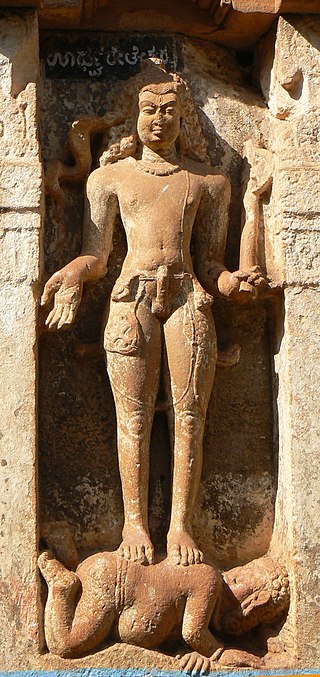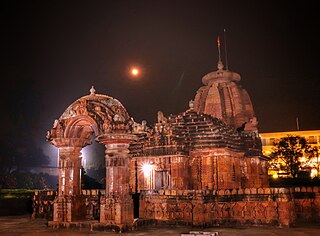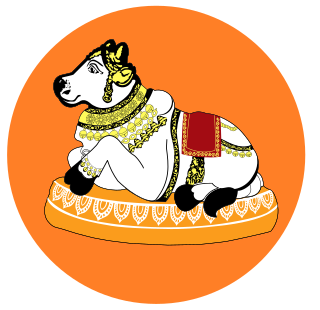
Chandragupta II, also known by his title Vikramaditya, as well as Chandragupta Vikramaditya, was the third ruler of the Gupta Empire in India.

Shaivism is one of the major Hindu traditions, which worships Shiva as the Supreme Being. One of the largest Hindu denominations, it incorporates many sub-traditions ranging from devotional dualistic theism such as Shaiva Siddhanta to yoga-orientated monistic non-theism such as Kashmiri Shaivism. It considers both the Vedas and the Agama texts as important sources of theology. According to a 2010 estimate by Johnson and Grim, Shaivism is the second-largest Hindu sect, constituting about 253 million or 26.6% of Hindus.

Pattadakal, also called Raktapura, is a complex of 7th and 8th century CE Hindu and Jain temples in northern Karnataka, India. Located on the west bank of the Malaprabha River in Bagalkot district, this UNESCO World Heritage Site is 23 kilometres (14 mi) from Badami and about 9.7 kilometres (6 mi) from Aihole, both of which are historically significant centres of Chalukya monuments. The monument is a protected site under Indian law and is managed by the Archaeological Survey of India (ASI).

The Udayagiri Caves are twenty rock-cut caves near Vidisha, Madhya Pradesh primarily denoted to the Hindu gods Vishnu and Shiva from the early years of the 3rd century CE to 5th century CE. They contain some of the oldest surviving Hindu temples and iconography in India. They are the only site that can be verifiably associated with a Gupta period monarch from its inscriptions. One of India's most important archaeological sites, the Udayagiri hills and its caves are protected monuments managed by the Archaeological Survey of India.

Bappa Rawal was a king of the Mewar kingdom in Rajasthan, India. The chronicles describe him as a member of the Guhila Rajput Clan, and some of them consider him to be the founder of the Guhila dynasty. He is credited with repelling the Arab invasion of India. He was renowned with the name "Maharaja Kaalbhoj", which meant a praise for his extremely powerful arms. He is identified as the ruler of the Guhila dynasty, and called by the names Kalabhoja, Shiladitya, and Khumana.

Lakulisha was a prominent Shaivite revivalist, reformist and preceptor of the doctrine of the Pashupatas, one of the oldest sects of Shaivism.
Shiva Sutras are a collection of seventy seven aphorisms that form the foundation of the tradition of spiritual mysticism known as Kashmir Shaivism. They are attributed to the sage Vasugupta of the 9th century C.E.

Mukteshwara Temple is a 10th-century Hindu temple dedicated to Shiva located in Bhubaneswar, Odisha, India. The temple dates back to 950–975 CE and is a monument of importance in the study of the development of Hindu temples in Odisha. The stylistic development the Mukteswara marks the culmination of all earlier developments, and initiates a period of experiment which continues for an entire century, as seen in such temples as the Rajarani Temple and Lingaraj temple, both located in Bhubaneswar. It is one of the prominent tourist attractions of the city.

Pashupata Shaivism is one of the oldest major Shaivite Hindu schools. The mainstream which follows Vedic Pāśupata penance are 'Mahāpāśupata' and the schism of 'Lakula Pasupata' of Lakulisa.

Vāsudeva, later incorporated as Vāsudeva-Krishna, Krishna-Vāsudeva or simply Krishna, was the son of Vasudeva Anakadundubhi, king of the Vrishnis in the region of Mathura. He was a leading member of the Vrishni heroes, and may well have been an historical ruler in the region of Mathura.

Budhagupta was a Gupta emperor and the successor of Kumaragupta II. He was the son of Purugupta and was succeeded by Narasimhagupta.
The Gwalior Inscription of Mihirakula is a Sanskrit inscription recording the construction of a Surya temple from stone on the Gopa hill of Gwalior. Though now referred with the name of Mihirakula, the temple and the inscription was commissioned by Matricheta. The original temple is lost, and the inscribed red-sandstone slab was found in 1861 by Alexander Cunningham in the porch of another temple, and published in 1861. This inscribed stone from Gwalior was moved shortly after its discovery to the Kolkata museum for preservation. Several translations of it have been published thereafter. It is damaged, its script is the northern class of ancient Gupta script and the entire composition is in poetic verse.

Rudrasena I was a ruler of the Nandivardhana-Pravarapura branch of the Vakataka dynasty. He was the grandson and one of the successors of Pravarasena I.
The Parivrajaka dynasty ruled parts of central India during 5th and 6th centuries. The kings of this dynasty bore the title Maharaja, and probably ruled as feudatories of the Gupta Empire. The dynasty is known from inscriptions of two of its kings: Hastin and Samkshobha.

The Reh Inscription was discovered in 1979 near the Reh archaeological site along Yamuna River about 350 kilometres (220 mi) east of Mathura in India. It is a Prakrit inscription in Brahmi script near the bottom of a Shiva linga. The inscription is dated to between the 2nd century BCE and 2nd century CE based on the script style.
The Vasu Doorjamb Inscription is an early 1st-century CE Sanskrit inscription in Brahmi script dedicated to the deity Vāsudeva, related to the Vaishnavism tradition of Hinduism. It is also one of the several dedicatory inscriptions from Mathura bearing the name of the Indo-Scythian Northern Satrap ruler Sodasa, which are useful as historic markers for the first half of the 1st century CE.

The Gadhwa Stone Inscriptions, or Garhwa Stone Inscriptions, are early 5th-century CE Sanskrit inscriptions discovered in Uttar Pradesh relating to a series of charitable donations to various sattra (almshouses) by Gupta Empire rulers Chandragupta II and Kumaragupta I. The inscription is notable for including symbols for numerals "8, 10, 80 and 90" in the 5th-century, as well as mentioning the ancient city of Pataliputra.
The Vadathika Cave Inscription, also called the Nagarjuni Hill Cave Inscription of Anantavarman, is a 5th- or 6th-century CE Sanskrit inscriptions in Gupta script found in the Nagarjuni hill cave of the Barabar Caves group in Gaya district Bihar. The inscription is notable for including symbol for Om in Gupta era. It marks the dedication of the cave to a statue of Bhutapati (Shiva) and Devi (Parvati). The statue was likely of Ardhanarishvara that was missing when the caves came to the attention of archaeologists in the 18th-century.

The Gopika Cave Inscription, also called the Nagarjuni Hill Cave Inscription II of Anantavarman or formerly the Gya inscription, is a 5th- or 6th-century CE Sanskrit inscription in Late Brahmi found in the Nagarjuni hill cave of the Barabar Caves group in Gaya district, Bihar, India.

Gupta art is the art of the Gupta Empire, which ruled most of northern India, with its peak between about 300 and 480 CE, surviving in much reduced form until c. 550. The Gupta period is generally regarded as a classic peak and golden age of North Indian art for all the major religious groups. Gupta art is characterized by its "Classical decorum", in contrast to the subsequent Indian medieval art, which "subordinated the figure to the larger religious purpose".




















